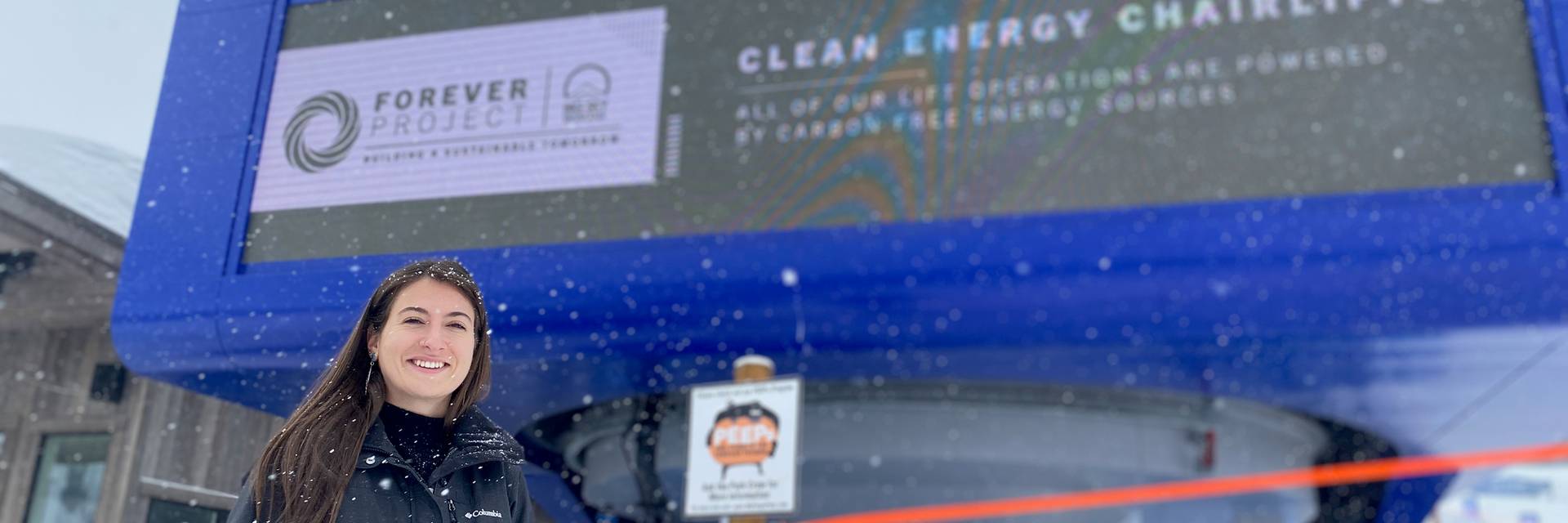
The Sustainability Specialist
What it Takes: on any given day, it takes approximately 935 people with a wide array of skills and knowledge to make Big Sky Resort run. Together, these individuals form a complex, agile human machine that is constantly adjusting to changing conditions. This series chronicles “what it takes” to operate the resort through the eyes of some of these people.
It’s snowing in the Mountain Village—big, gorgeous, sculpted flakes. Skiers are loading on Swift Current, Ramcharger, and Explorer.
On the first floor of the Huntley, behind a nondescript door in the hallway between the lobby and Chet’s, Amy Fonte is at her desk in the resort’s accounting office, uploading data on energy use into the resort’s sustainability dashboard as she does at the start of every month.
One monitor shows the spreadsheet she’s working in, and on the other is a series of colored bar graphs. The database combines the same information from each of the 12 properties owned by Boyne Resorts, Big Sky’s parent company, creating a baseline for energy use as the company works toward its goal of net zero carbon emissions by 2030.
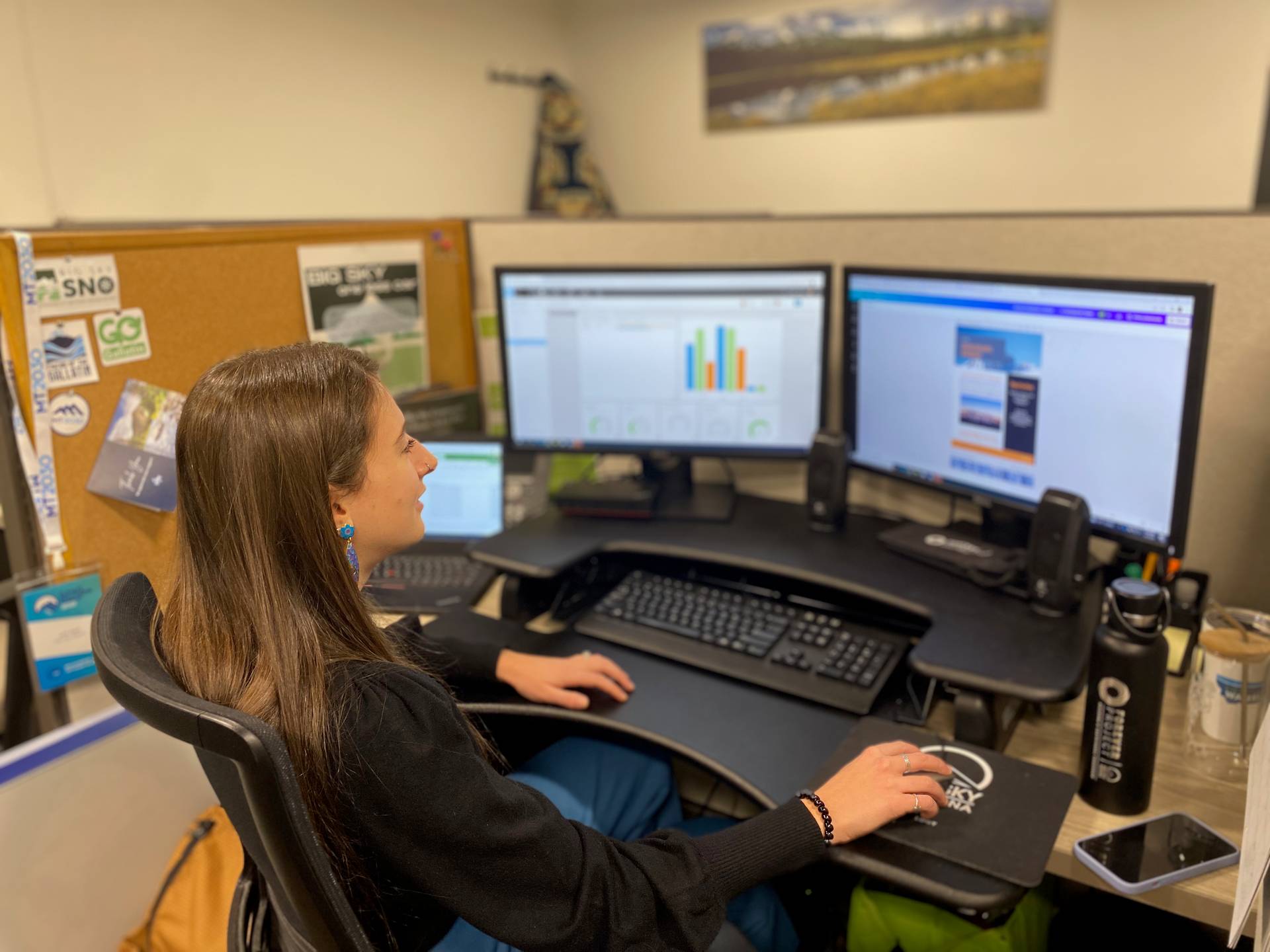
“That baseline will set us up for targets and metrics,” explains Fonte, Big Sky Resort’s sustainability specialist. “That's how we don’t greenwash. We [need to] have all the data, proof, and evidence that we’re doing things.”
Fonte’s data comes directly from utility and fuel bills, which is why she’s in the accounting department.
“This is our data from last year,” she says, pointing to the bar graphs. “It’s all of our bills. I enter every piece of data, what kind of emission it is, where it's coming from, what we're using, and then this graph shows me, for a certain period of time, what emissions were.”
When this is built out, she says, they’ll have real-time emission data that shows whether a certain system—say, a particular chairlift or snowmaking system—is using more energy.
“That way,” Fonte says, “we can address it.”
Fonte, 28, started at the resort in July of 2021 after earning a Masters in Sustainability Management. Growing up in Florida, she and her three siblings learned to ski on family vacations up and down the East Coast, road-tripping to places like Sugar Mountain in North Carolina and Killington in Vermont.
She’s got a sharply analytical mind and a deft hand at building and managing programs like the resort’s compost and recycling streams, but she doesn’t get stuck in spreadsheets. Or compost bins, for that matter.
Earlier this morning, she was working on a new Boyne-wide sustainability newsletter, which she and her counterpart at Sunday River, Kate Matthews, launched in December to highlight what different resorts are doing and inspire action for things like climate and energy action. It’s part of their work as leaders of Boyne Resorts’ advocacy committee, tasked with helping all 12 properties do more effective environmental advocacy.
Included in this newsletter was a recent letter in opposition to a proposed bill that would have devalued solar. When Fonte heard about the bill on a Friday through the Montana Renewable Energy Association, she dropped what she was doing—working with maintenance manager Marc Perdue on where to hang new “No Idling” signs—did some research and made some calls, then drafted the letter. The following Monday, it went out to Jane Gillette, who represents the community of Big Sky in the Montana legislature, signed by the resort’s general manager, Troy Nedved.
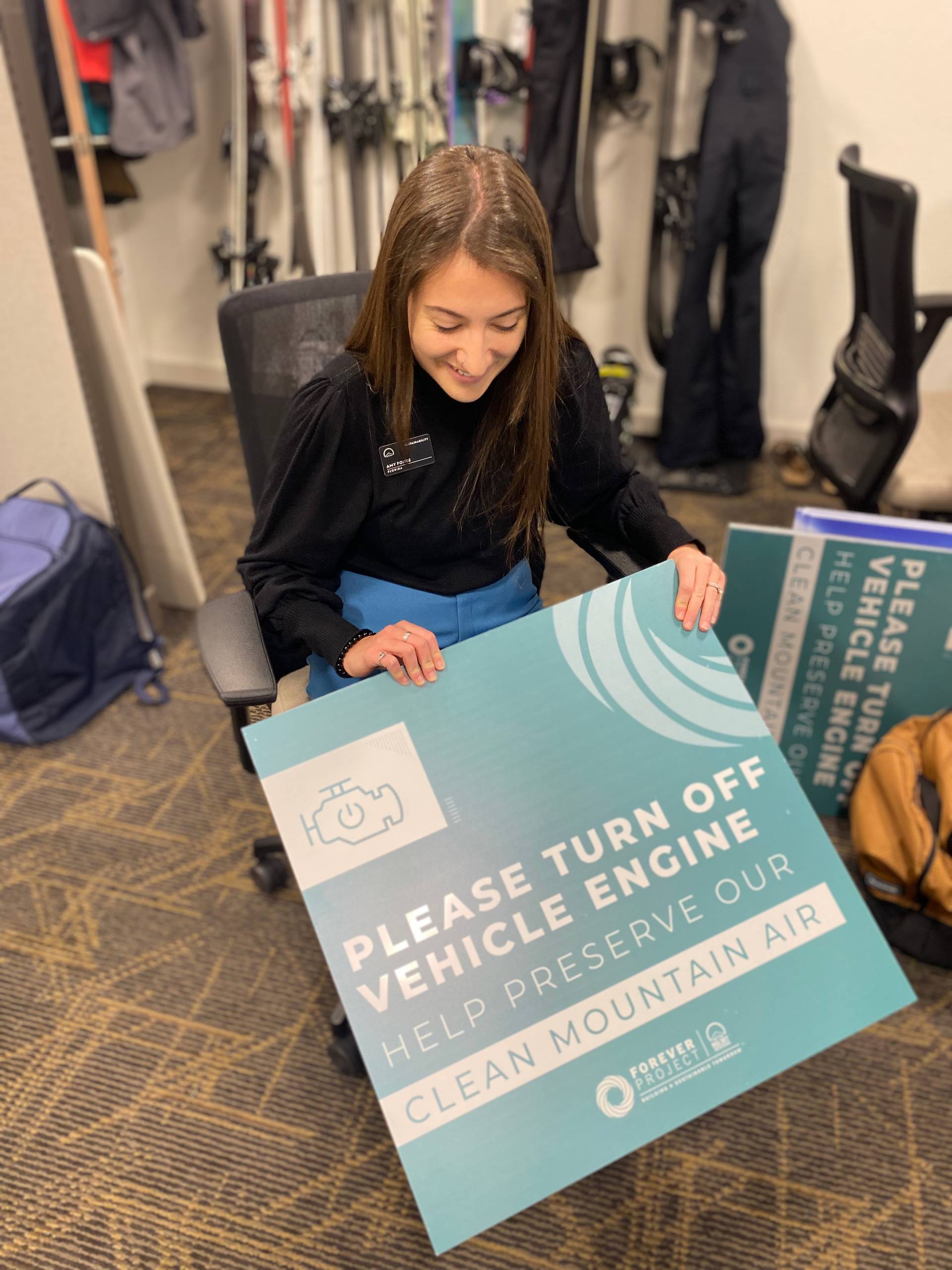
As participants in the National Ski Area Association Climate Challenge, all of Boyne’s resorts, including Big Sky, are required to do four acts of advocacy a year, at minimum. In addition to political advocacy like the letter, NSAA’s definition of advocacy includes things like engaging customers or the local community to care about climate change.
The Climate Challenge also requires participants to implement a new carbon reduction project every year and report annual greenhouse gas emissions, publishing them in the NSAA annual report. The challenge is part of the organization’s , which holds more than 200 participating ski areas accountable for improving their operations in areas like waste streams, water quality, and building construction.
Fonte stands up from her desk and zips a coat over her office clothes, which include wide-leg royal blue pants from the 1970s.
“We can go to the loading dock area,” she says, then calls Cyrus Brown, the sous chef in Vista Hall, to check on the compost stations.
“Cyrus is really advocating for recycling and composting,” she tells me once she hangs up. “He'll let me know if a bin is over-full or if we need a recycling pick up.”
She stops by a recycling station in the Huntley Lobby beside the bear statue and explains that many of the resort’s sustainability initiatives are currently waste-related.
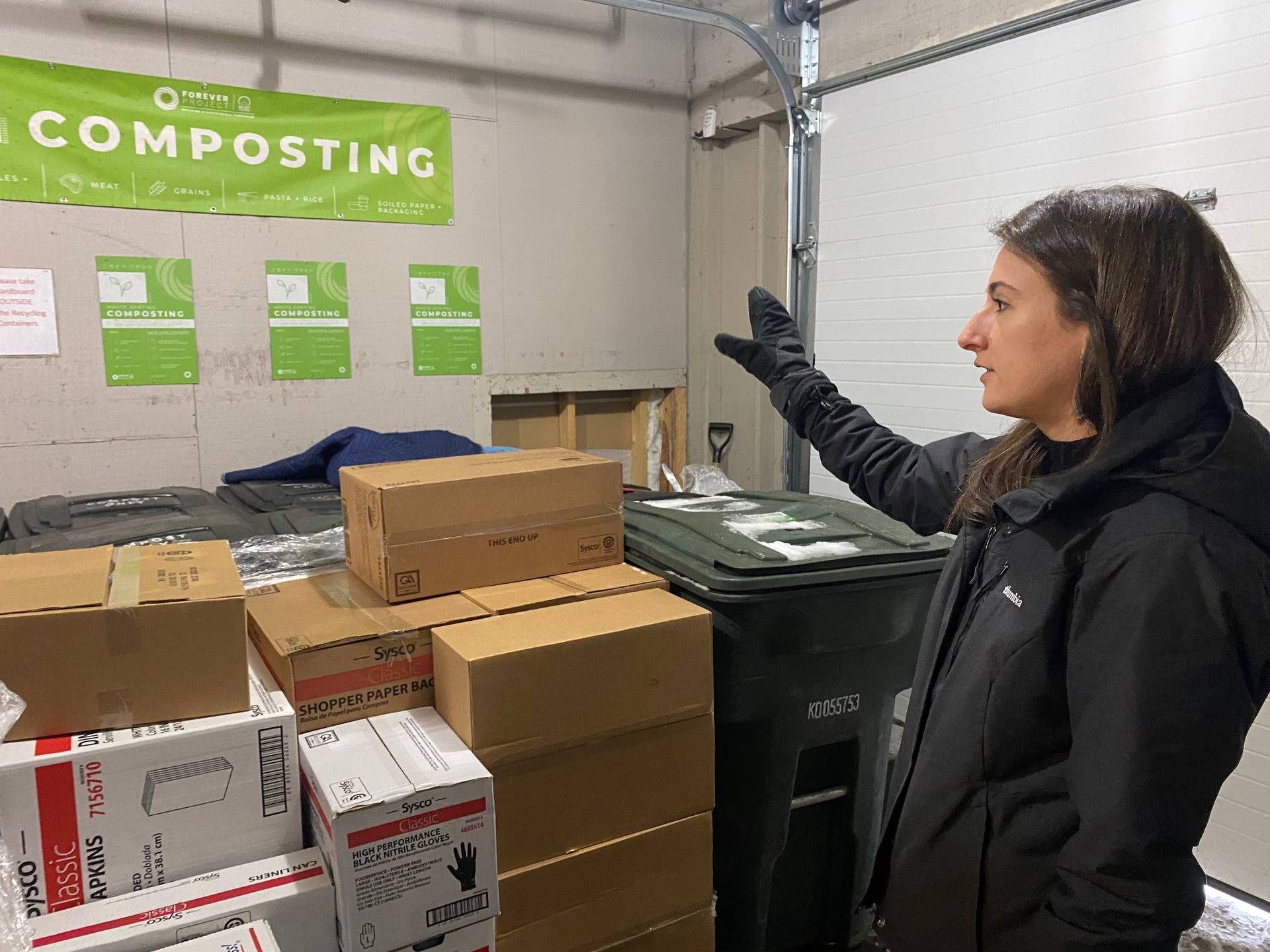
“A lot of our employees care about it, and the waste bins are visible,” she says. “The first step is to show people you are doing things.”
She’s working with the lodging department and Boyne’s interior design team to create a new bin with removable sections, kind of like Legos. This way, if one of the waste streams changes—if glass or plastic cup recycling becomes available in Montana, for example—they could replace one bin instead of the entire system.
At the Huntley loading dock, Fonte heaves a bag of cans from one bin, where they’re overflowing, to another with more room.
“This is our supply chain where everything happens,” she says, pointing out the trash compactor and bins for compost and plastic, aluminum, and electronics recycling.
Fonte estimates that the resort diverted over 20 tons of food waste from the landfill in 2022 and had a total diversion rate of 30%, meaning a third of its total waste stayed out of the landfill. That percentage includes municipal and construction waste and has increased 7% year over year from 23% in 2021.
More than anything, Fonte says, success here depends on educating other employees on what’s available and getting them on board and bought in — basically building a network of internal advocates.
For that, she likes to start small-scale.
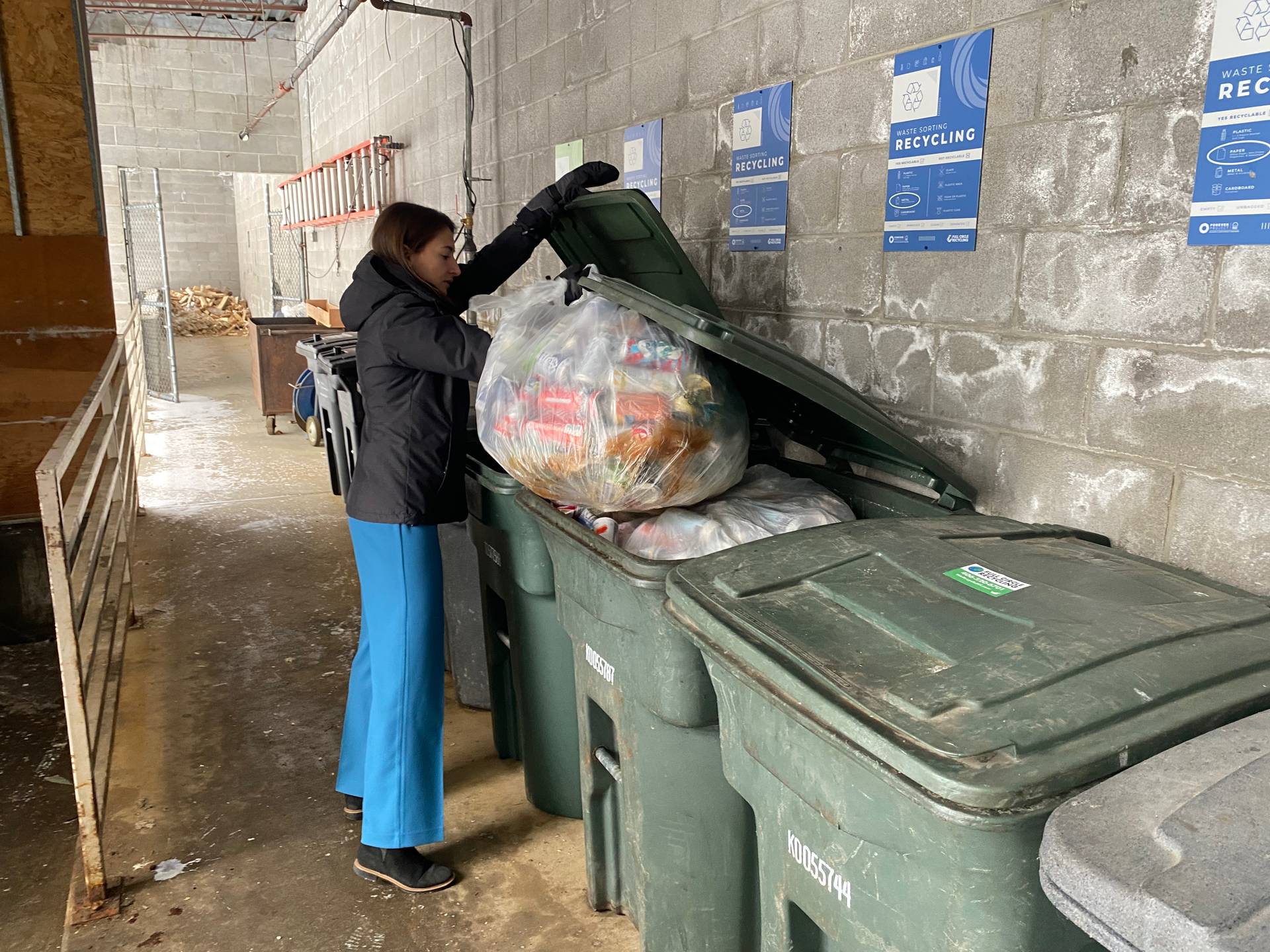
With compost, for example, the previous sustainability specialist started the compost program with bins at Vista Hall in 2020. In 2021, Fonte expanded it to Westward Social, Montana Jack, and Mocha in the Huntley, working with Belgrade-based YES Compost to hone the program and train employees to prevent contamination. The following year, she added bins to the remaining five food and beverage outlets at the resort and, this March launched composting and recycling stations at employee housing.
“It’s about designing the system for a closed loop,” Fonte said. “Whatever you put in, you’re utilizing the output for new inputs, rather than a cradle-to-grave system where we produce things and throw them away.”
In addition to her day-to-day work, Fonte spent the last year helping develop Boyne’s plan to reach net zero as part of the ForeverProject, Boyne’s overarching sustainability commitment. She and Mari Kissinger, director of sustainability for another Boyne property, The Highlands at Harbor Springs, acted as project managers, working closely with leadership from both Big Sky and Boyne, as well as the Colorado-based Brendle Group, a consulting firm with a 30-year track record in sustainability that has developed climate action plans for others including the City of Bozeman and Taos Ski Valley. Fonte and Kissinger also helped flesh out the plan, creating a priority list and an action plan from Brendle’s recommendations.

Published in April, the ForeverProject Master Plan lays out a comprehensive roadmap to get all of Boyne’s properties to net zero by 2030.
From managing the creation of this landmark plan to partnering on a stream restoration project or a community climate action plan, to planning electrification of the resort’s vehicle fleet, Fonte’s work depends on the combination of analytical and people skills.
“She can run the numbers, and she understands the nuances, if we do this or that, what the implications are in terms of progress towards quantitative targets,” said Judy Dorsey, president and principal engineer at Brendle. “But she's also a real connector.”
Dorsey puts a lot of weight on Fonte’s role in the community.
“It’s very important for the resort and the community to be working on [their climate action plans] at the same time,” she said.
In the face of climate change, large-scale solutions will only develop through collective action.
“We have to both think about it in the real big perspective, and make sure that [what we do] on the small scale fits into that,” said Taylor Middleton, the resort president, who works closely with Fonte on the ForeverProject. “But we also have to understand that it's all the small-scale stuff that builds the political momentum and the support and warms people's hearts. It's going to take a combination of the big stuff at the global governmental level to really move the needle, plus tons of people—voters—to elect the public officials that are going to make the policy changes to get this done.”
Middleton says one of the resort’s roles is as a bullhorn.
“If we can show people the way to clean energy that doesn't create climate change and pollute the environment... that creates a flywheel of public support behind doing environmental good.”
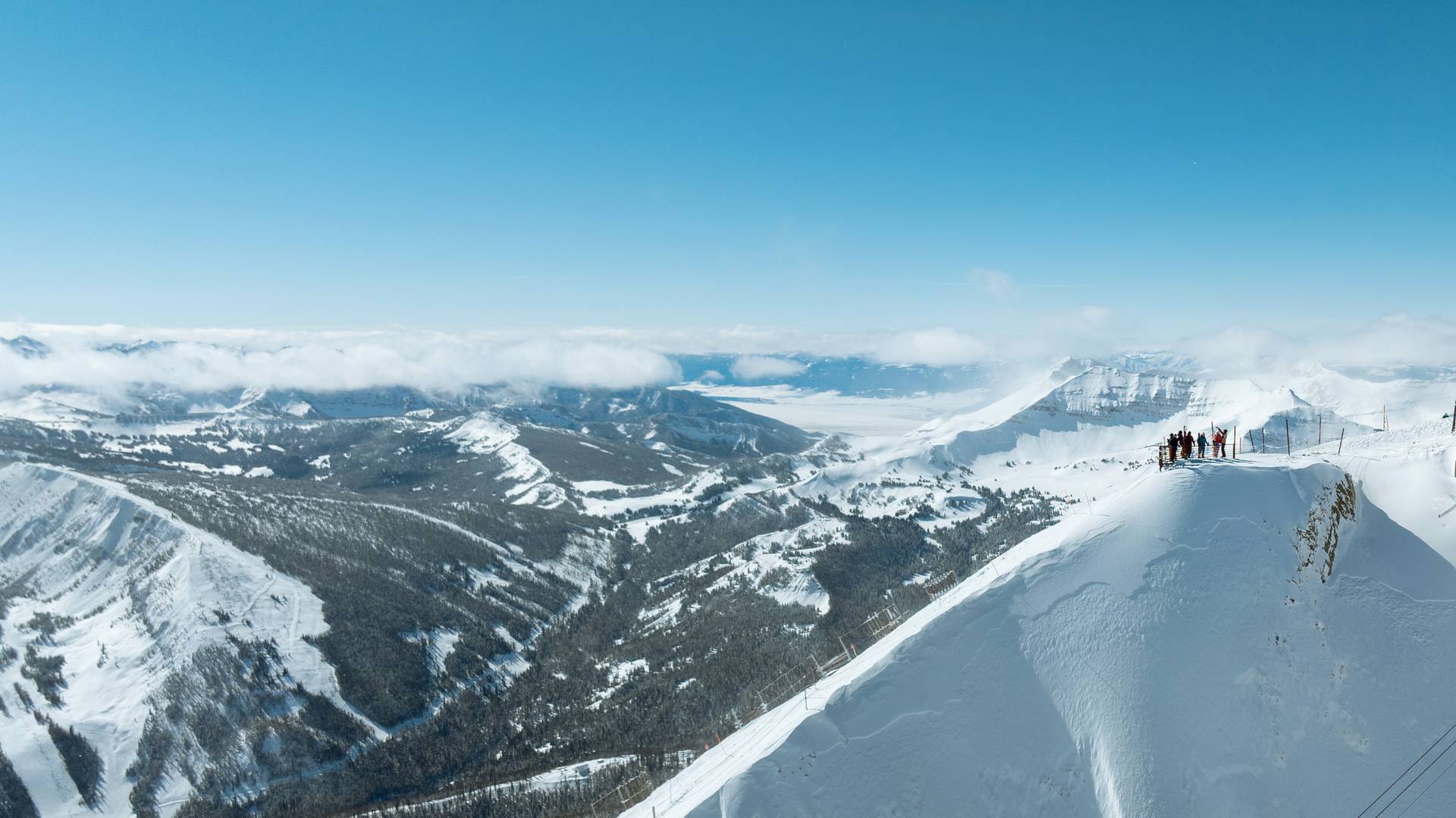
Big Sky Resort and Boyne haven’t always been outspoken like this on climate — that has developed in the last few years, Middleton says. But if you look around, you’ll realize an interest in environmental protection isn’t new here. Several Boyne resorts, including Big Sky, formed green committees 20-plus years ago, which developed recycling initiatives, and you can find Middleton quoted in a local newspaper around that same time vowing never to discharge treated wastewater into the Gallatin River. Big Sky hired its first sustainability specialist in 2018 and launched The Big Picture, the ForeverProject’s predecessor, the following year.
The critical moment for sustainability at Boyne came in 2019, when Stephen Kircher, Boyne’s president, attended the first annual Mountain Towns 2030 Net Zero Summit in Park City, Utah. There, alongside leaders of the three other largest ski resort corporations in North America, he committed publicly to net zero by 2030.
“I think the ski industry is the canary in the coal mine,” the Park Record quoted Kircher as saying. “We’re not a big industry relative to the global economy, but we power something that can make loud noise and drive change.”

In June 2021, those companies — which together own 77 ski resorts — announced what became the Mountain Collaborative for Climate Action, a joint pledge to incorporate sustainable practices, aggressively pursue renewable energy, advocate for climate action at all policy levels, and leverage their purchasing power and economies of scale to fight climate change.
None of this indicates a halt or even a slowdown in development in the fast-growing community of Big Sky or at the resort itself. Instead, it’s a new way of doing business, led by Kircher, driven by people like Amy Fonte, and supported by the web of relationships Amy and her peers are building right now.
“A lot of these climate change actions aren't overnight,” said Courtney Jones, the resort’s controller and Fonte’s direct manager. “These are [multi-year] projects that she has to plan for in advance. If we are going to get our fleet electrified, we need to be thinking about how to get the infrastructure in now so that three or four years down the road, when it’s available, we can get it done quickly.”
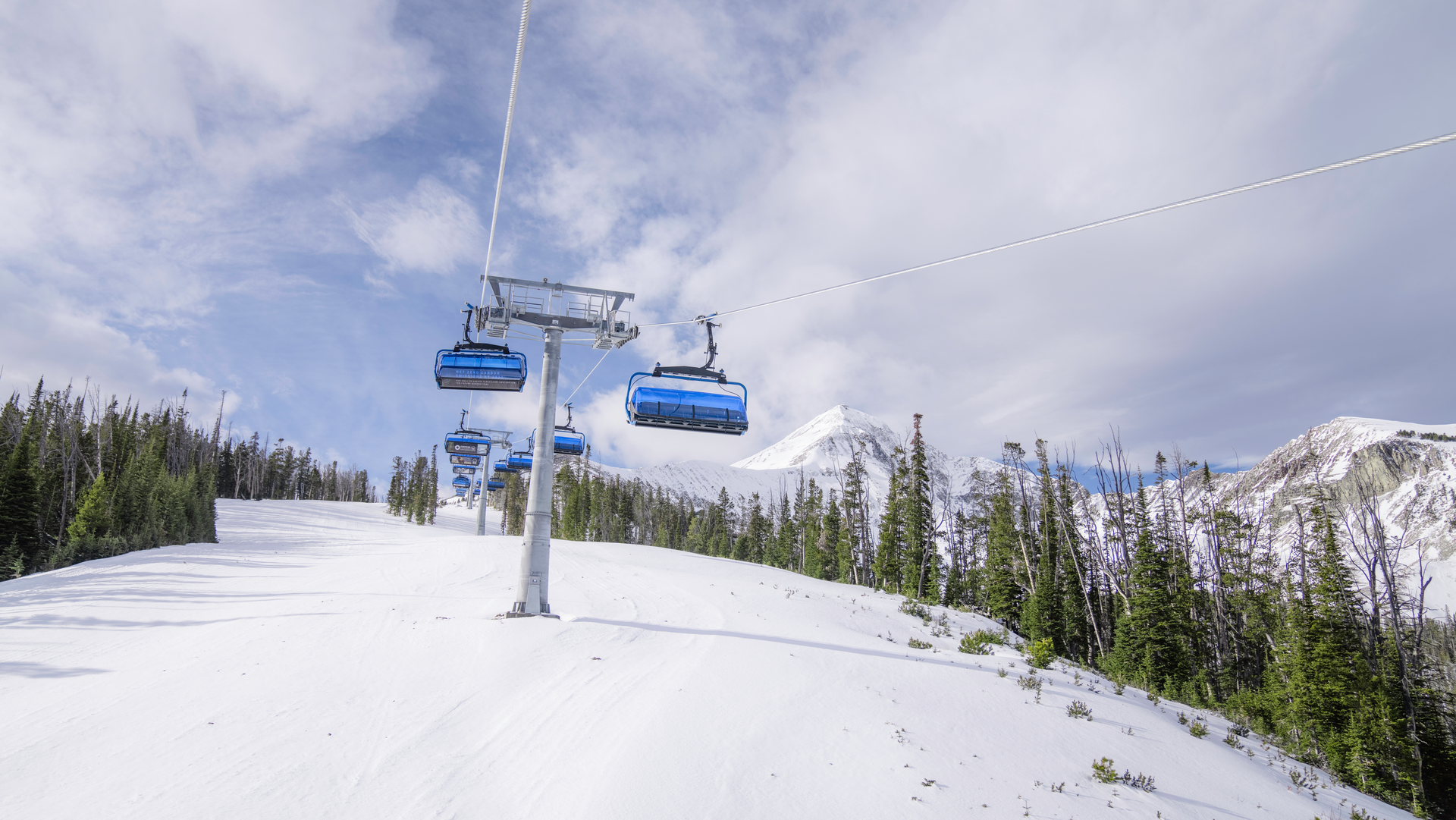
While Fonte’s work is in its early days, she’s already received national recognition, helping earn Big Sky Resort a NSAA Golden Eagle Award for Community and Partnerships.
Back at the Huntley loading dock, that means Fonte is working with the mail crew manager to divert magazines to the BASE community center or the local school; helping the woman in charge of purchasing explore more sustainable options and establish electronics recycling and uniform donation programs; and assisting the maintenance team to find rebates or other savings for Energy Star appliances. She attends meetings with the food and beverage directors, mountain operations, and construction, always reminding people she’s there as a resource.
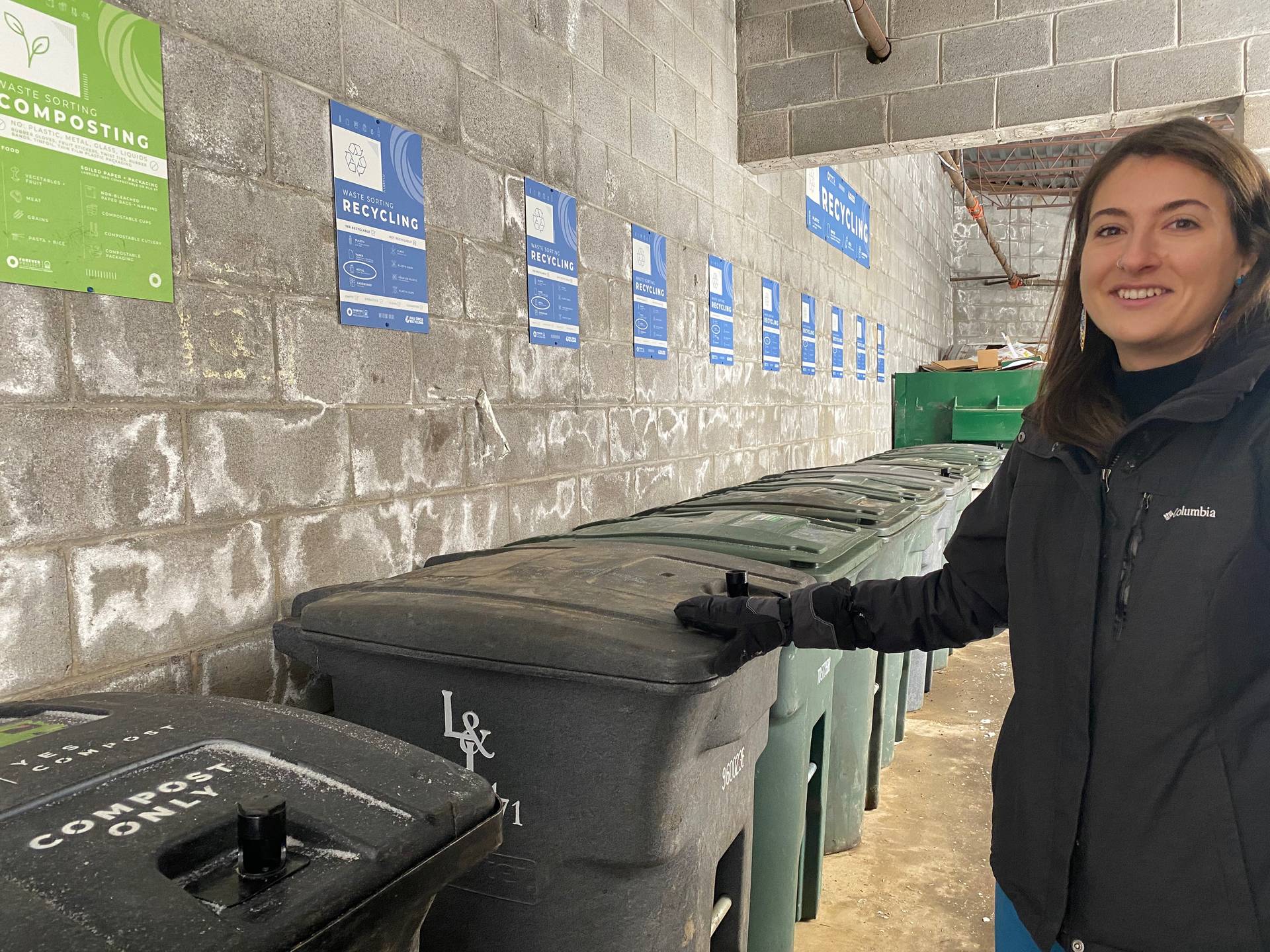
One person she talks with even more regularly is the resort’s facilities maintenance director, Marc Perdue.
“She definitely made me think differently since she’s been here,” said Perdue, who manages a 30-person crew. “I work in maintenance and construction, and I’ve filled up many dumpsters in my time. Now I think twice about it. I save stuff more, and I bug her to get it recycled.”
Perdue even jokes about getting a t-shirt made with the slogan, ‘What would Amy do?’
But it doesn’t stop at the resort. Fonte, Middleton, and the local climate action group Big Sky SNO are also working with the City of Bozeman, Bridger Bowl, and several other Montana cities to encourage NorthWestern Energy to provide a renewable rate option.
With the fastest-growing electrical demand in all of NorthWestern’s Montana grid, the community of Big Sky has significant buying power.
“That’s where we can make the most leverage for change, is using our business voice for advocacy,” Fonte says. She recently collaborated with Bridger’s sustainability director, Bonnie Hickey, to draft a guest column on behalf of both ski areas, encouraging Montana’s senators to enact legislation that would decrease carbon pollution.
“We believe the federal government should set a goal to reduce U.S. emissions 50% by 2030,” they wrote, “speeding the production of cleaner, cheaper, non-carbon-based energy that is not impacted by foreign supply chain disruption and conflict overseas.”
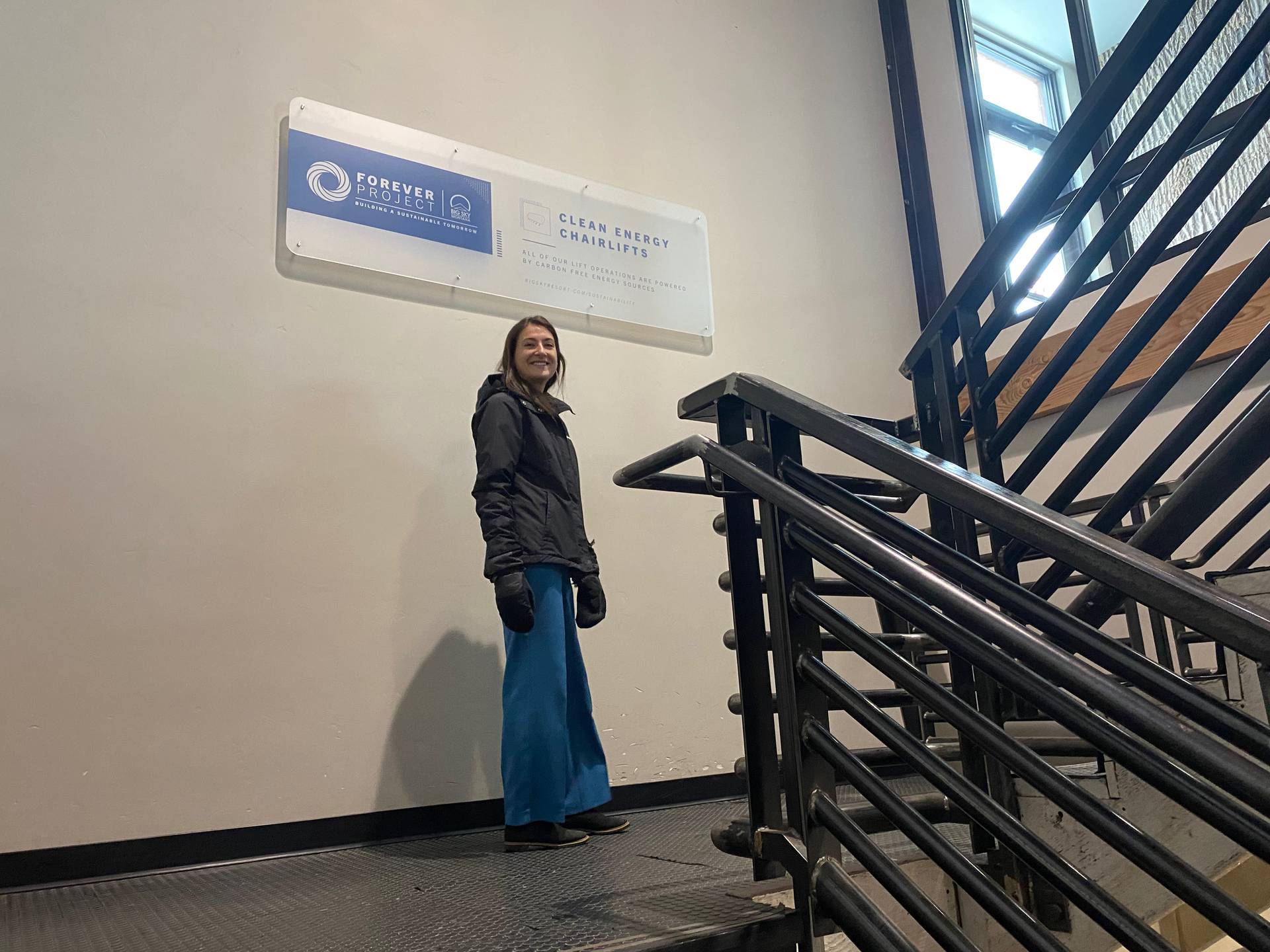
Back at the resort, Fonte leaves the Huntley and heads over to the Exchange, breezing through the building’s loading dock. Pallets holding boxes of vegetables, onion rings, and beer block access to the compost and recycling bins.
“We’re always strapped for space,” she says.
Another challenge is the nature of working with a seasonal workforce, which is why Fonte makes a point to build relationships with managers and directors, who can, in turn, train their teams.
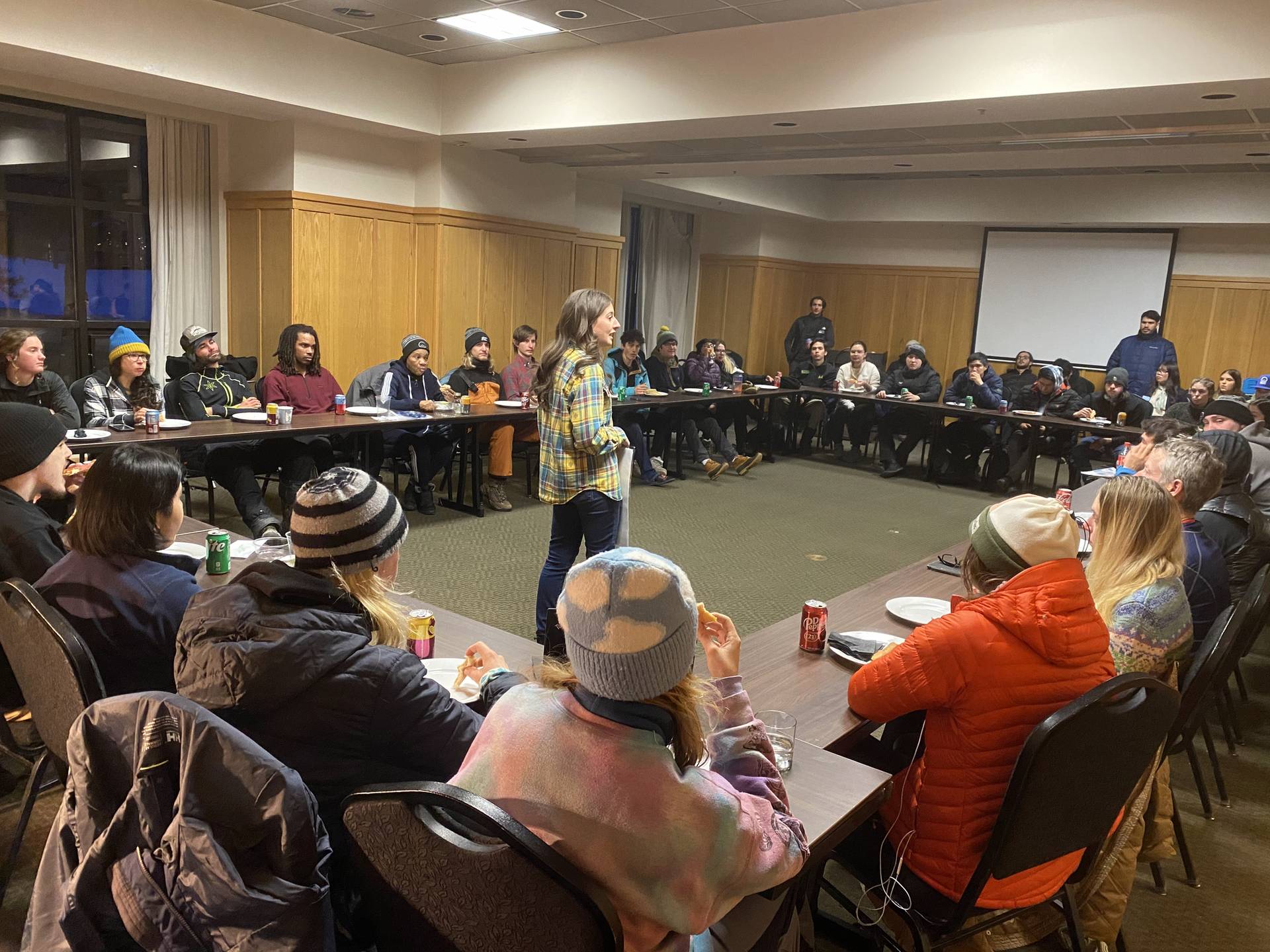
Photo Credit: Amanda Muller
She walks through Vista Hall, pointing out the reusable silverware and the condiment dispensers, which create less waste than individual packets. Both of those were part of a resort-wide effort to phase out all disposables, she said, crediting food and beverage leaders for the changes.
In the Mountain Village, Fonte’s impact is everywhere.
There’s the Snowcrest Building, home to the Snowsports School, where the resort electrician recently installed LED lighting, and the Summit Hotel, which, together with all resort hotels, has a new HVAC system with occupancy sensors in each room for heating and cooling. There’s even a trash can in the plaza tagged with a ForeverProject sticker.
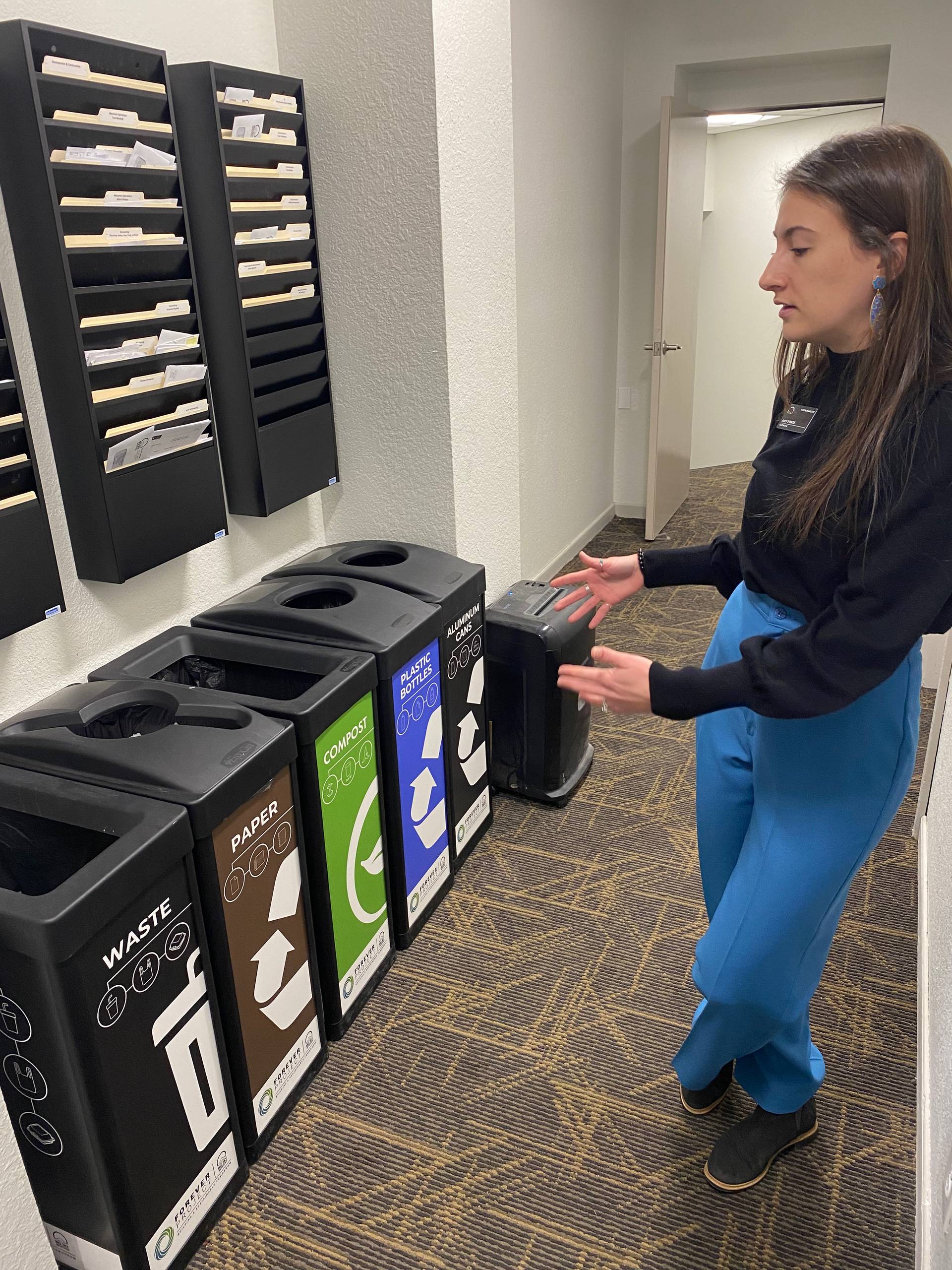
Snowflakes land on Fonte’s long, brown hair as she climbs the stairs to the base of Swift Current.
Skiers load onto the six-person chairs, and the bubbles glide down over their heads, revealing wildlife photos on the chairbacks, each meant as a reminder of the resort’s commitment to the ecosystem that surrounds Big Sky, the Greater Yellowstone. As she waits for the LED screen above the lift to switch over to the ForeverProject, Fonte talks about other projects she’s worked on with partners outside of the resort.
There was the stream restoration project below Lake Levinski in partnership with the local nonprofit, Gallatin River Task Force. The resort supplied a saw crew to help build beaver dam analogs to slow the water’s downstream travel and recharge the wetland there, while the task force provided volunteers, and the Moonlight Foundation and the local resort tax board helped fund the project, including a consultant who identified the site, alongside several others in the community.
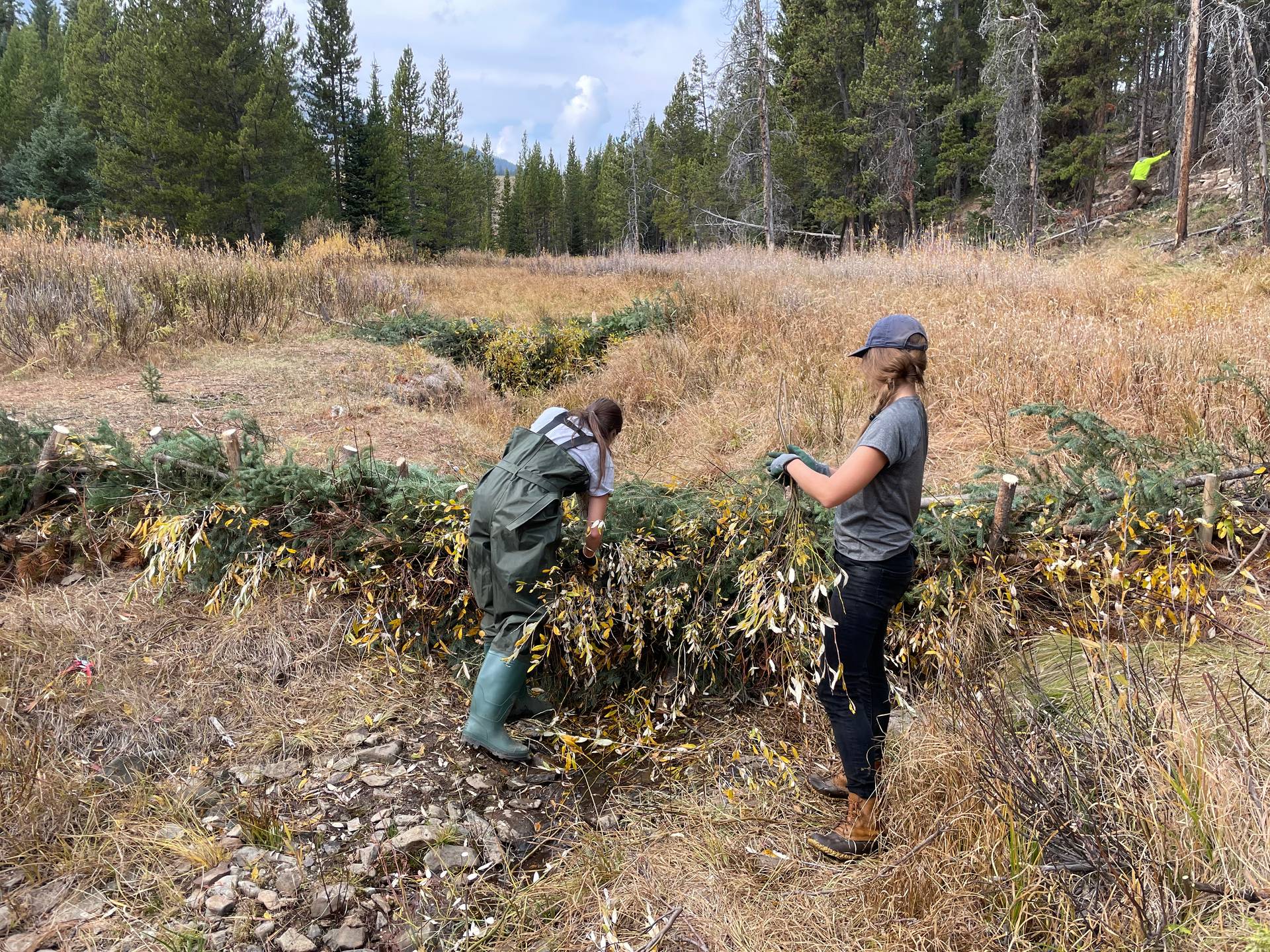
Photo Credit: Emily O'Connor
Back at her desk, Fonte scrolls through photos of the river restoration project, which she herself volunteered for.
“I'm a huge advocate for volunteerism,” she says.
She also volunteers with the local climate action group, Big Sky SNO, and works so closely with its director of community sustainability, Lizzie Peyton, that the two of them finish each other’s sentences. And Fonte is on the Montana Prevention Certification Board, where she works on substance abuse prevention, a field she’s familiar with from a previous job doing research and data analysis on opiates and meth elsewhere in Montana.
After that foundational experience, Fonte is firm in her belief that environmental sustainability requires a strong social component.
“Basically, making sure people have what they need to survive and live a good life — education, health, mental health, as well as resources for all those things like a living wage, food, and shelter. [That will help build capacity to work on] environment, climate change, water and land use change, forests, and biodiversity.”

Fonte (left) laughs with Lizzie Peyton (right), the director of community sustainability for Big Sky SNO, who Fonte volunteers with.
As she looks beyond the 2030 net-zero goal, Fonte would like to see the resort add more solar arrays, as well as smaller-scale wind infrastructure when viable, and continue working on things like water and waste streams. But mostly, she wants to integrate this ethos into the company culture.
“Ideally, sustainability is something everybody is doing.”
With that, she says, the resort can maximize its impact.
“Corporations have so much power and influence. How do you use that to make a positive impact? So many people come to Big Sky to ski. If we can tap into their interest in skiing and the outdoors for greater sustainability, that’s what the whole world needs to do.”
Emily Stifler Wolfe is a writer and business consultant based in Bozeman, Montana, and a former ski patroller in Big Sky. Find her at emilystiflerwolfe.com.
More to Explore
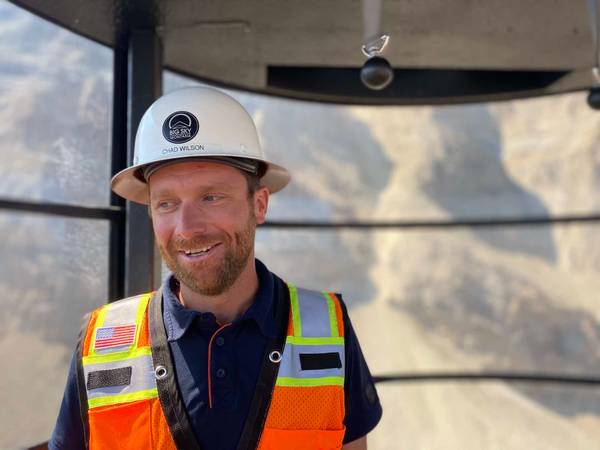
The VP of Construction & Development
What does it take to keep Big Sky Resort’s vision for the future on track? Meet Chad Wilson, the driving force behind every construction project at Big Sky Resort.
Read More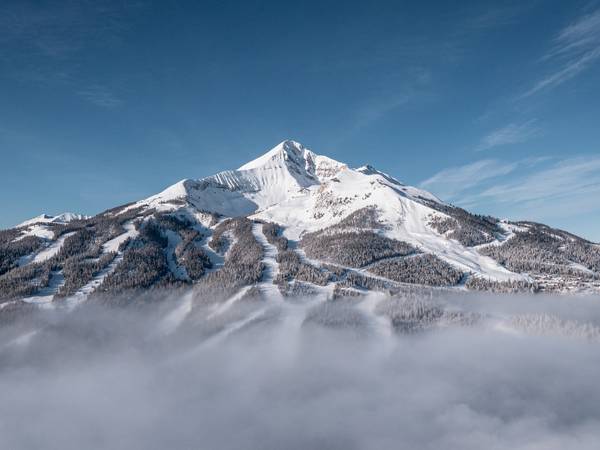
The Greater Yellowstone Ecosystem: A Rare Place Indeed
Charles Post was working as a field research assistant on the remote South Fork Eel River in Northern California when he first grasped the power of photography.
Read More







